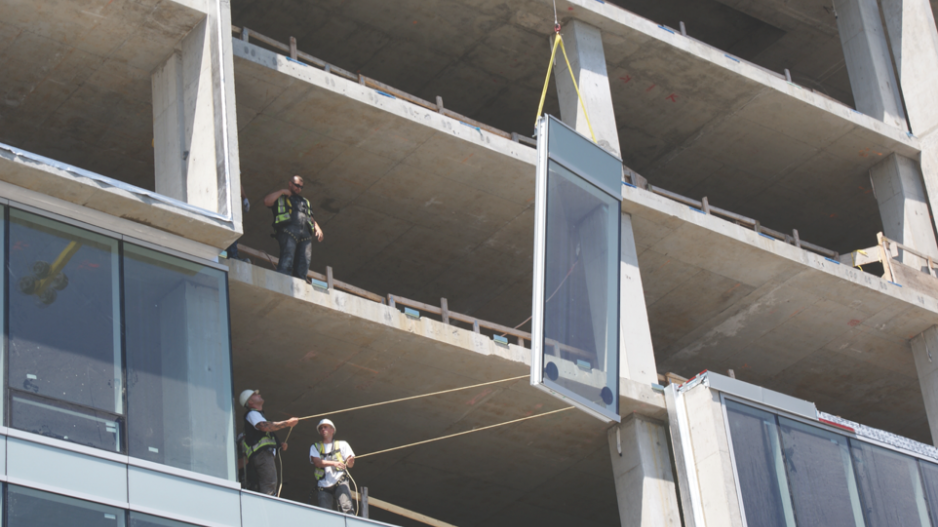For many years the City of Vancouver has been striving to be “the greenest city in the world.” Through its Greenest City Action Plan, Vancouver has made a lot of progress towards this goal. As a further step, the city recently released its new Green Buildings Policy for Rezonings.
This policy was reported in November 2016 and comes into effect on May 1, 2017, when rezoning applications within the city of Vancouver must meet these new requirements.
What are these requirements and how do they affect the commercial building sector?
As its title suggests, the main goal of this policy is to move buildings towards a low or near zero emissions (carbon) goal. The policy provides various options for meeting these targets, such as Passive House or the International Living Future Institute’s Net Zero Energy Building Certification; however, this article will focus on the path that most applicants will likely take.
This requires meeting specific annual total energy use intensity (TEUI), thermal energy demand intensity (TEDI) and greenhouse gas intensity (GHGI) targets. TEUI is the total amount of energy a building uses per square metre in a year (ekWh/sqm). TEDI is the energy used to heat and cool a building in a year. GHGI is the equivalent carbon emissions that result from the energy used by the building in a year. The above table summarizes these requirements for buildings not connected to a city-recognized low-carbon-energy system, which will be most buildings.
What does this mean for new commercial buildings? Let’s review the requirements for new office buildings. For reference, per survey data from the Building Owners and Managers Association (BOMA), the average TEUI for a Level 4 BOMA BEST certified commercial office building in 2014 was 186 ekWh/sqm. Note that Level 4 certification represents fairly high-performing buildings in terms of energy use. The new City of Vancouver target is 100 ekWh/sqm. While this is an aggressive target, it isn’t as difficult to achieve as it sounds. This TEUI target is a modelled energy target, and is based on specific energy modelling rules and assumptions that the city has published. These rules and assumptions will generally result in lower modelled energy use than the building would use once completed. My firm, Dialog, has completed energy models for various types of buildings in relation to the new rezoning policy, and has found that generally, with good building envelope design and high-performance building systems that are common today, the TEUI targets can be met.
On the other hand, the TEDI and GHGI targets will be more difficult to meet. The TEDI targets are aggressive, and unlike with the TEUI, the modelling assumptions and rules will not significantly reduce the modelled TEDI. For reference, the average BOMA BEST Level 4 building with a TEUI of 186 ekWh/sqm mentioned above would likely have a TEDI somewhere between 50 and 90 ekWh/sqm. The rezoning target for office buildings is 27 ekWh/sqm. There are some strategies that could be incorporated to help meet these TEDI targets; however, these are not currently typically included in commercial buildings. Examples include triple-glazed windows, heat recovery ventilation and other forms of heat recovery, increased building envelope insulation, and highly efficient building heating and cooling systems.
The other requirement that may cause some difficulty is the GHGI targets. This is because most commercial buildings are heated by natural gas, which has a relatively high greenhouse gas (GHG) emissions factor. With 97 per cent of our electricity in B.C. generated by hydro, our electricity has a very low GHG factor. For comparison, the GHG factor for electricity is 0.011 kilograms carbon dioxide equivalent per kilowatt hour (kgCO2e/kWh), while the factor for natural gas is 0.185 kgCO2e/kWh, almost 17 times higher than that for electricity. To meet these factors, the use of natural gas should be very closely scrutinized and, where possible, switched to electricity. An option is to use renewable natural gas (RNG). RNG is generated as a byproduct from other organic processes, such as landfills, farms and waste-water treatment facilities. The problem with this option is that demand for RNG is already outstripping current supply. As demand for RNG increases, it may become more economically viable to increase supply.
This brings us to the final question that I’m sure is on everyone’s mind. How will the new City of Vancouver rezoning requirements affect the cost of commercial buildings? As with any new requirement, there will be an initial learning curve for the industry, and this will result in an initial increase in the cost to construct new commercial buildings. However, similar to the LEED (Leadership in Energy and Environmental Design) rating system, as the industry adapts, the systems and strategies required will soon become common, and the costs will level out.
Rod Yeoh, P.Eng., P.E., LEED AP BD+C, is a principal of Dialog, Vancouver. Yeoh’s work with Dialog includes the award-winning City of Vancouver National Avenue Works Yard, the first building to be LEED certified by the Canadian Green Building Council; the Fred Kaiser Engineering Building at UBC, acclaimed for its energy efficiency; and several BC Hydro facilities designed to meet LEED Gold and Platinum equivalents. Visit www.dialogdesign.ca.




